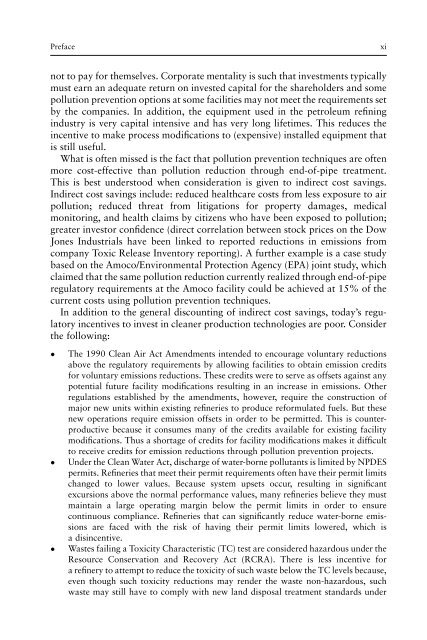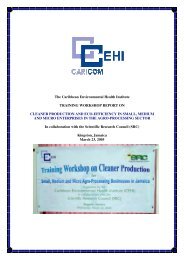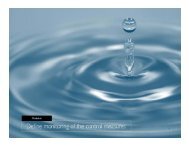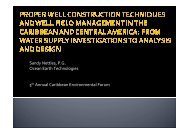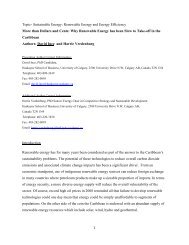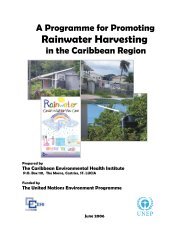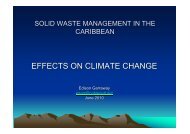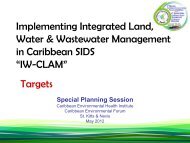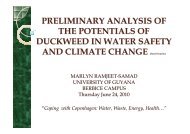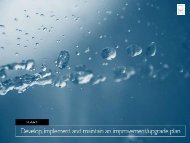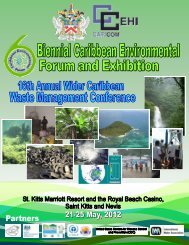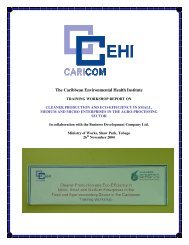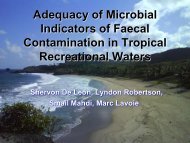best practices for the petroleum industry - Caribbean Environmental ...
best practices for the petroleum industry - Caribbean Environmental ...
best practices for the petroleum industry - Caribbean Environmental ...
Create successful ePaper yourself
Turn your PDF publications into a flip-book with our unique Google optimized e-Paper software.
Prefacexinot to pay <strong>for</strong> <strong>the</strong>mselves. Corporate mentality is such that investments typicallymust earn an adequate return on invested capital <strong>for</strong> <strong>the</strong> shareholders and somepollution prevention options at some facilities may not meet <strong>the</strong> requirements setby <strong>the</strong> companies. In addition, <strong>the</strong> equipment used in <strong>the</strong> <strong>petroleum</strong> refining<strong>industry</strong> is very capital intensive and has very long lifetimes. This reduces <strong>the</strong>incentive to make process modifications to (expensive) installed equipment thatis still useful.What is often missed is <strong>the</strong> fact that pollution prevention techniques are oftenmore cost-effective than pollution reduction through end-of-pipe treatment.This is <strong>best</strong> understood when consideration is given to indirect cost savings.Indirect cost savings include: reduced healthcare costs from less exposure to airpollution; reduced threat from litigations <strong>for</strong> property damages, medicalmonitoring, and health claims by citizens who have been exposed to pollution;greater investor confidence (direct correlation between stock prices on <strong>the</strong> DowJones Industrials have been linked to reported reductions in emissions fromcompany Toxic Release Inventory reporting). A fur<strong>the</strong>r example is a case studybased on <strong>the</strong> Amoco/<strong>Environmental</strong> Protection Agency (EPA) joint study, whichclaimed that <strong>the</strong> same pollution reduction currently realized through end-of-piperegulatory requirements at <strong>the</strong> Amoco facility could be achieved at 15% of <strong>the</strong>current costs using pollution prevention techniques.In addition to <strong>the</strong> general discounting of indirect cost savings, today’s regulatoryincentives to invest in cleaner production technologies are poor. Consider<strong>the</strong> following:The 1990 Clean Air Act Amendments intended to encourage voluntary reductionsabove <strong>the</strong> regulatory requirements by allowing facilities to obtain emission credits<strong>for</strong> voluntary emissions reductions. These credits were to serve as offsets against anypotential future facility modifications resulting in an increase in emissions. O<strong>the</strong>rregulations established by <strong>the</strong> amendments, however, require <strong>the</strong> construction ofmajor new units within existing refineries to produce re<strong>for</strong>mulated fuels. But <strong>the</strong>senew operations require emission offsets in order to be permitted. This is counterproductivebecause it consumes many of <strong>the</strong> credits available <strong>for</strong> existing facilitymodifications. Thus a shortage of credits <strong>for</strong> facility modifications makes it difficultto receive credits <strong>for</strong> emission reductions through pollution prevention projects.Under <strong>the</strong> Clean Water Act, discharge of water-borne pollutants is limited by NPDESpermits. Refineries that meet <strong>the</strong>ir permit requirements often have <strong>the</strong>ir permit limitschanged to lower values. Because system upsets occur, resulting in significantexcursions above <strong>the</strong> normal per<strong>for</strong>mance values, many refineries believe <strong>the</strong>y mustmaintain a large operating margin below <strong>the</strong> permit limits in order to ensurecontinuous compliance. Refineries that can significantly reduce water-borne emissionsare faced with <strong>the</strong> risk of having <strong>the</strong>ir permit limits lowered, which isa disincentive.Wastes failing a Toxicity Characteristic (TC) test are considered hazardous under <strong>the</strong>Resource Conservation and Recovery Act (RCRA). There is less incentive <strong>for</strong>a refinery to attempt to reduce <strong>the</strong> toxicity of such waste below <strong>the</strong> TC levels because,even though such toxicity reductions may render <strong>the</strong> waste non-hazardous, suchwaste may still have to comply with new land disposal treatment standards under


